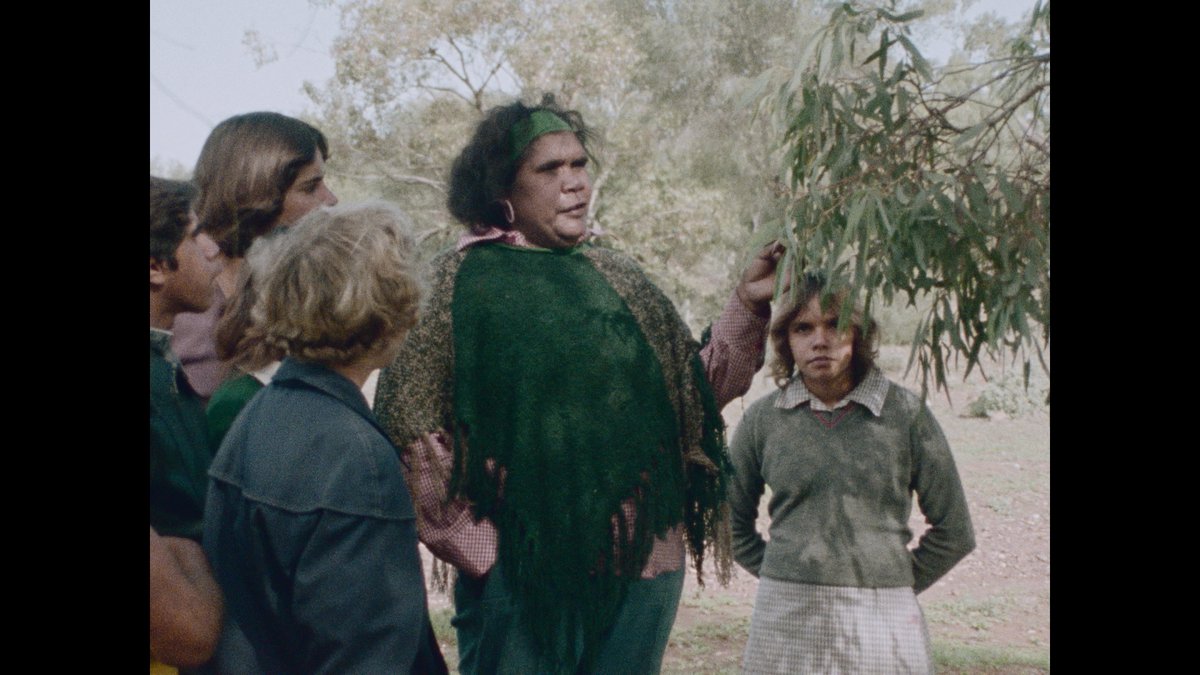Essie Coffey OAM was a Murawarri activist, advocate and filmmaker concerned about the influence of white culture and education on Indigenous children. As seen in her groundbreaking documentary, My Survival as an Aboriginal (1978), she taught culture – and the importance of cultural knowledge – to her community. Importantly, her documentary also exposed how First Peoples were marginalised in all aspects of their lives, from school to wider society. The treatment of First Peoples laid bare in her documentary reached wider audiences through screenings at prestigious Australian and international film festivals, where the film won numerous awards. For her dedicated services to the Indigenous Australian community, Coffey herself was awarded an Order of Australia.
Curator Notes
Aunty Essie Coffey was affectionately known as the Bush Queen of Brewarrina, also known as Dodge City, a town specifically built to house Aboriginal people that the government was displacing from their lands.
In the opening sequence of the film, Coffey describes the injustices her community faces. She turns the camera on herself, speaks from her own experiences, and talks directly to the viewer, making clear what she wants for her community, which is self-determination, to manage their own affairs and continue practising culture to combat assimilation.
The film captures the heartbreak of a strong woman rearing children – witnessing attempts to whitewash them through the education system and what they’re consuming on television – as well as the impacts of government policy, alcoholism and the judicial system.
“Most important that you kids just remember what you are, that you stand tall and you stand proud, on your own land what you’re standing now, and it is black land, Aboriginal land," she tells the children in the film.
At the same time, Coffey embeds her wit into the film, evident in a dramatised two-minute scene where the camera pulls away from children watching television to zoom in on Coffey’s face, as though we are entering her mind. We still hear the voices from the television and its laugh track, but we are transported to a scene where Coffey, dressed like a glamorous 70s housewife, is standing in a well-to-do kitchen among the latest in white goods. The colour treatment on the film is toned down, creating a flat, bland palette. She opens the fridge door, bringing out a jug full of orange juice and takes a sip. The clip repeats and each time the pace quickens.
We then see Coffey clocking on to a job in a factory. The sounds of the industrial machinery grow louder and louder, the sound of a clock ticks faster and faster. The soundscape and sharp juxtaposition of imagery gives the scene a horror-like quality. In this scene, Coffey flips the script on the standard practice of non-Indigenous people making films about Indigenous people, by being a Blak woman making a film about white people. She refuses to assimilate and conveys white life not as desirable, but as a horrific, solitary life destined for doom.
Coffey used documentary to amplify her outspoken voice, paving the way for future generations of documentary-makers and truth tellers. She overcame barriers that aimed to keep Aboriginal women silent and broke down stereotypes of what an Aboriginal woman is. In My Survival as an Aboriginal, Coffey spoke directly to the audience, abolishing the idea that Aboriginal women are docile, stoic or in need of saving – she staunchly advocates that Aboriginal people can take care of Aboriginal affairs and takes pride in her culture. No longer were we being spoken about, and not to.
– Assistant Curator Kate ten Buuren
Learn more about My Survival as an Aboriginal with these resources from the National Film and Sound Archive of Australia.
My Survival as an Aboriginal: lessons on survival
My Survival as an Aboriginal: go away
My Survival as an Aboriginal: zigzag
Works in this group
The legacy of Essie Coffey, told by her daughter Sharon Ruby Dykes
Related articles
Related works
Related events
Content notification
Our collection comprises over 40,000 moving image works, acquired and catalogued between the 1940s and early 2000s. As a result, some items may reflect outdated, offensive and possibly harmful views and opinions. ACMI is working to identify and redress such usages.
Learn more about our collection and our collection policy here. If you come across harmful content on our website that you would like to report, let us know.
Collection
Not in ACMI's collection
On display until
16 February 2031
ACMI: Gallery 1
Credits
Collection metadata
ACMI Identifier
Curatorial section
The Story of the Moving Image → Moving Australia → MA-07. First Peoples: Our stories, our way → MA-07-03 Essie Coffey


